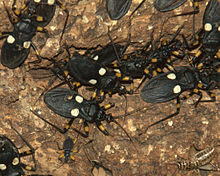 |
| P.biguttatus |
Beetles, along with butterflies, lacewings, true flies and wasps, bees and ants have a lifecycle based on complete metamorphosis. The egg hatches into a larva which in no way resembles the adult, grows through a series of moults, and finally forms a pupa from which the reproductive adult form emerges. This lifecycle appears to have evolved only once, probably in the late Carboniferous, and this group (the Holometabola) comprises the vast bulk of modern insect diversity. True bugs on the other hand retain the original insect developmental pathway – the egg hatches into a nymph which resembles a small adult except for lacking wings, and as it grows each moult results ina stage more like the final adult form.
Often confused with beetles, we have only one of the true bugs on show at Bristol, the Two-Spot Assassin Bug Platymeris biguttatus. They originate from Central Africa, where there are many similar species. They are quite secretive and nocturnal, hiding away under loose bark or inside hollow logs, where groups of them can often be found. When hungry, they emerge from their hiding places in pursuit of prey, usually small beetles, cockroaches, and similar size invertebrates. Their usual hunting method is to stab their prey in the back (hence their common name) with their piercing mouthparts, injecting a toxic saliva which liquefies the inside of the prey insect and enables them to suck up the contents. If attacked, they will also bite in self defence, and as their venom is quite potent their bite is painful.
They do not, however, need to bite to defend themselves. They can also spray toxic secretions in the face of an attacker, and if this gets in a handlers eyes the result can be quite serious – for which reason the keepers always wear goggles when having to work in their display. Their distinctive patter is another example of warning colouration, and their sociable tendencies also reinforces the defence – a mongoose trying to attack a colony of assassin bugs will not forget the lesson quickly!
Many bugs exhibit parental care, often brooding the eggs to provide defence or even gluing them to the parent’s body, but this does not appear to be the case with assassin bugs. The eggs are simply dropped in a suitable spot where humidity is reasonably high and left to their own devices. They are fairly long lived insects, reaching maturity in perhaps 9 months and living as long as two years in captivity.
As a result of their defences and retiring nature, assassin bugs probably do not have many vertebrate predators. Their main risk is probably spiders and parasitic wasps or flies, which attack practically every living insect species at at least one point in their life cycle. They are not endangered in the wild, and are unlikely to become so in the near future.
(images from wikipedia)
No comments:
Post a Comment